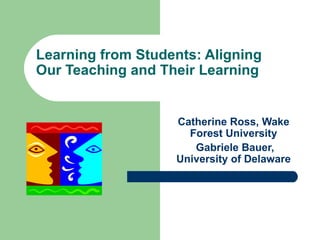
Learnfromstudents11s ross
- 1. Learning from Students: Aligning Our Teaching and Their Learning Catherine Ross, Wake Forest University Gabriele Bauer, University of Delaware
- 2. Purpose Provide context for formative student feedback. Define feedback, assessment, formative and summative. Examine various data collection methods. Develop student feedback questions for your courses.
- 3. Before we start, what do we mean? Feedback Assessment Formative and summative CATs
- 4. Current practice? Do you collect formative feedback from your students How do / would your students respond? How has the feedback been helpful?
- 5. Why collect formative student feedback? Collect student perceptions on their learning experience. -- get a sense of the impact of instructional practices on student learning. -- make adjustments during the course. -- consider post-course improvement. Help students become self-aware of their learning and involved. Confirm, explain, correct our self-assessment of instruction – help us better understand the critical link between learning and teaching.
- 6. Classroom Assessment Techniques (CATs) Approach designed to help instructors find out what students are learning in class and how well they are learning it: information about change in student learning. Both teaching tool and assessment device (formative). Reference. Cross, P., & Angelo, T. (1993). Classroom assessment techniques.
- 7. Classroom Assessment Techniques (CATs) Learner-centered Instructor-directed Mutually beneficial Instructional context-specific Ongoing, short-term oriented Non-graded (quick read, don’t agonize) Conducted in class
- 8. Considerations for Using CATs Explain purpose: What will the students and I learn from this CAT? Ongoing process. Provide feedback regarding CAT to students – make feedback data public: Feedback matters. Anonymous. Feedback informs teaching practice. Changes norms of student involvement.
- 9. Items Open-ended Questions – Clarification/details – Not all possible responses are known – No statistical analysis Closed-ended Questions – Likert Scale – Multiple Choice – Ordinal – Categorical – Numerical
- 10. Examples Open-ended, teaching directed: – What could we do to improve your learning in this class? – Start, Stop, Continue – Index card: What’s working? What’s not working? – Brief questionnaire: no more than 12 questions (pace, assignments, use of class time, etc.)
- 11. Examples Open-Ended, Learning Directed: – Most Important Point, Muddiest Point – Clickers – At what moment in this class this past week did you feel most engaged? Most distant? – What about this class this week surprised you the most? What action by the teacher did you find most helpful? Most confusing?
- 12. Common Mistakes Too specific Too general Leading Too many items in one question Too many questions
- 13. Working with Student Feedback - Guidelines Content analysis, look for recurring themes, frequency of comments. Try not to over-generalize (all instruction doesn’t work equally well for all students). Put negative comments in perspective. Focus on student learning (not “do they like me?”). Identify constructive ways to use the feedback.
- 14. Side Benefits Student perspective of teaching environment – reflective teaching. Sense of community, builds trust: “our class” Student ownership – reflective learners. Reinforcement of what supports student learning (what students do, what the instructor does). Alerts to problems before disaster develops.
- 15. Caveats Don’t ask questions to which you don’t want the answer. Ask students about aspects of their learning experience that you can do something about and are willing to change. You don’t need to incorporate all students’ suggestions: Pedagogical judgment.
- 16. Next Steps Decide what you want to assess. Schedule feedback at appropriate times. Encourage meaningful feedback: tell students you will summarize, ask for concrete examples, observable behaviors, give preferences and alternatives Use different techniques through out the term.
- 17. Sources for Evaluating Teaching Effectiveness Instructor Self Report Student Perception Data Colleague Evaluation Student (external) Performance Administrator Peer Evaluation Evaluation (internal) Provided by: Don Wulff, Ph.D., University of Washington, 1995.
- 18. Student Feedback Is like a dancer’s mirror. It improves one’s ability to see and improve one’s performance. Alexander Astin, 1993
- 19. References Classroom Assessment Techniques (CATs) provided by Field-tested Learning Assessment Guide for science, math, engineering, and technology instructors, University of Wisconsin-Madison. Faculty across disciplines talk about why they have used a particular CAT in their teaching and examples are provided. <http://www.flaguide.org/cat/cat.php> Cross, P., & Angelo, T. (1993). Classroom assessment techniques: A handbook for college teachers (2nd ed.). San Francisco: Jossey-Bass. Huba, M., & Freed, J. ((2000). Learner-centered assessment on college campuses. Needham Heights, MA: Allyn & Bacon. Chapter 5. Lang, J. (2007). Did you learn anything? The Chronicle of Higher Education Chronicle Careers, March 5. <http://chronicle.com/jobs/news/2007/03/2007030501c/careers.html> Suskie, L. (2004). Assessing student learning. A common sense guide. Bolton, MA: Anker Publishing. Weimer, M. (1993). Improving your classroom teaching. Newbury Park, CA: Sage Publications. Chapter 7: Assessing their learning and your teaching, pp. 97-122.
Hinweis der Redaktion
- 10:10
